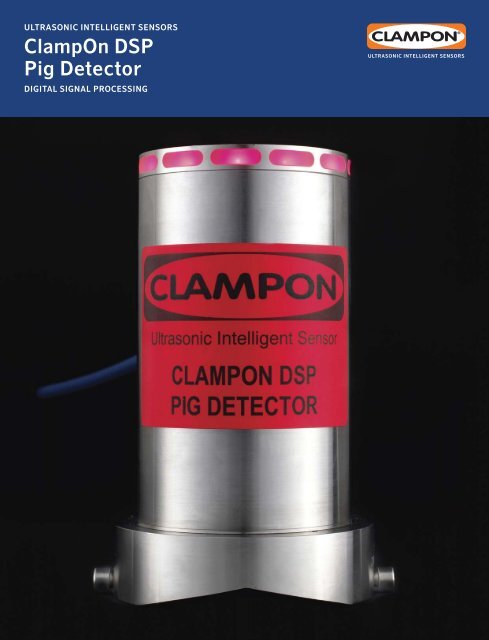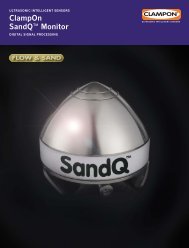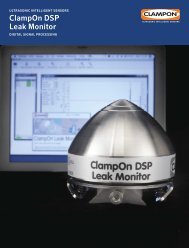ClampOn DSP PIG Detector Brochure
ClampOn DSP PIG Detector Brochure
ClampOn DSP PIG Detector Brochure
You also want an ePaper? Increase the reach of your titles
YUMPU automatically turns print PDFs into web optimized ePapers that Google loves.
ULTRASONIC INTELLIGENT SENSORS<br />
<strong>ClampOn</strong> <strong>DSP</strong><br />
Pig <strong>Detector</strong><br />
DIGITAL SIGNAL PROCESSING<br />
ULTRASONIC INTELLIGENT SENSORS
<strong>ClampOn</strong> <strong>DSP</strong> Pig <strong>Detector</strong><br />
A Pig <strong>Detector</strong> is a tool that is always used in pigging operations. This operation is part of the operator’s<br />
pipeline integrity management programme aimed at avoiding reduced capacity due to scale build-up or,<br />
in some cases, shut-down due to leakage, corrosion, erosion, etc. Pigging is also performed in some<br />
cases to separate changes of media being transported in a pipe.<br />
The <strong>ClampOn</strong> <strong>DSP</strong> Pig <strong>Detector</strong> controls<br />
and monitors when the pig is passing the<br />
point of installation. Providing reliable information<br />
about the passage of the pig<br />
increases pipeline integrity and produces<br />
cost savings.<br />
<strong>ClampOn</strong> pig detection systems perform<br />
this operation in a simple and safe way<br />
as they only monitor the pig from the outside<br />
of the pipe. The sensor is simply clamped<br />
onto the pipe, eliminating any need for<br />
welding or drilling during installation. There<br />
<strong>ClampOn</strong> Ultrasonic<br />
Intelligent Sensor<br />
• Non-invasive<br />
• Digital Signal Processing (<strong>DSP</strong>)<br />
• Complete digitalisation<br />
• No analogue filters, circuits or<br />
amplifiers<br />
• Two-way communication<br />
• Real-time measurement<br />
• Easy to relocate<br />
• Contains no moving parts<br />
• Can be mounted in hostile<br />
environments<br />
• Incorporates sensitive, intelligent,<br />
intrinsically safe sensors<br />
• Can be upgraded by software<br />
download<br />
• Can store up to 60 days of<br />
measurement data within the<br />
sensor itself<br />
• Self-testing capabilities<br />
• Built-in temperature sensor and<br />
accelerometer (optional)<br />
• User-friendly software for<br />
Windows 20 0 0/20 03/XP/NT4<br />
• Versatile - one and the same<br />
sensor can perform particle<br />
detection, pig detection,<br />
spectrum analysis and more,<br />
all available in the software<br />
package of your choice.<br />
is no need for inserts in the pig and the<br />
system is capable of detecting all types of<br />
pigs or plugs.<br />
Principle of operation<br />
The <strong>ClampOn</strong> <strong>DSP</strong> Pig <strong>Detector</strong>, based on our<br />
Ultrasonic Intelligent Sensor Technology,<br />
represents the latest state-of-the-art technology.<br />
This acoustic instrument accurately<br />
detects the passage of all types of pigs in<br />
real time, giving instant warning to the operator.<br />
Its signal output can also be used to<br />
indicate the amount of debris pushed<br />
ahead by the pig during pipeline cleaning<br />
operations. <strong>ClampOn</strong> pig detection systems<br />
have been successfully tested and used by<br />
a large number of clients for many years,<br />
and this latest model makes the system<br />
even more compact and reliable. <strong>DSP</strong> (Digital<br />
Signal Processing) represents leading-edge<br />
technology in this field and keeps us ahead<br />
of the competition.<br />
Digital Signal Processing<br />
The <strong>ClampOn</strong> <strong>DSP</strong> <strong>Detector</strong>, available in<br />
topside and subsea versions, is a more<br />
compact and user-friendly unit than other<br />
instruments on the market. It is easier to<br />
install in the field and easier to move to<br />
other locations.<br />
<strong>DSP</strong> involves complete digitalization<br />
of the system and the elimination of analogue<br />
filters. This technology is increasingly<br />
used in a wide range of “smart electronic<br />
devices” as it provides sufficient capacity to<br />
perform advanced signal-processing tasks<br />
in real time. Such devices include medical<br />
diagnostic instruments, radar and sonar<br />
systems and mobile phones. <strong>ClampOn</strong> is<br />
the only manufacturer of pig detection<br />
systems to use <strong>DSP</strong>, which enables the<br />
sensor to operate in several frequency<br />
ranges simultaneously, eliminating the<br />
danger of the detector being triggered<br />
by noise sources other than pigs.<br />
The sensor<br />
The sensor unit is made of stainless steel<br />
for topside units and titanium for subsea<br />
units, and is clamped to the outer surface of<br />
the pipe through which the pig is passing.<br />
The topside units are certified according to<br />
EEx ia IIB, or EEx d IIC. All sensors can be<br />
operated at pipe-wall temperatures ranging<br />
from –40 to +200°C. An unlimited number<br />
of sensors can be connected to a single<br />
computer for real-time measurements.<br />
The sensors transmit an ASCII signal to<br />
the control computer.<br />
Computer<br />
The signal from the sensors can be interfaced<br />
directly with any type of Main Control System.<br />
If a dedicated computer is required, <strong>ClampOn</strong><br />
can supply a PC equipped with our specialized<br />
software running on the Microsoft<br />
Windows Operating System. The computer<br />
is installed in a safe area and enables the<br />
operator to detect the passage of pigs in<br />
real time, as well as generating reports from<br />
one or more sensors.<br />
Field lamp / Reset button<br />
The topside sensors can also be supplied<br />
with an indicator lamp that lights up when<br />
the pig has passed as well as a button to<br />
reset the sensor.<br />
Cabling<br />
All cables can be supplied and terminated by<br />
<strong>ClampOn</strong>, with or without quick connector,<br />
or supplied by client.
System layout<br />
Field Area<br />
EEx ia IIB<br />
EEx ia IIB<br />
Light/reset<br />
EEx d IIC<br />
EEx d IIC<br />
Light/reset<br />
Compact<br />
Deepwater<br />
Subsea<br />
Power<br />
Supply<br />
Unit<br />
Safe area<br />
<strong>ClampOn</strong><br />
Computer<br />
Client<br />
Main Control<br />
System<br />
Subsea<br />
Control<br />
Module<br />
<strong>PIG</strong><br />
TCP/IP<br />
Client<br />
Network<br />
Signal<br />
Output<br />
Options<br />
- RS485<br />
- 4-20mA<br />
- RELAY
PRODUCT SPECIFICATIONS<br />
<strong>PIG</strong> DETECTOR<br />
Principle of operation Passive acoustics, intelligent sensor<br />
Type of pig All types<br />
Minimum Pig Speed 0.03 meter per second<br />
Method of installation Clamped to pipe surface, non-intrusive<br />
Sensor electronics Intelligent <strong>DSP</strong> electronics with signal processing<br />
Interface options All sensors can be supplied with: Digital RS485 (ASCII, binary, ModBus RTU),<br />
4-20mA (active/passive), Relay, reset.<br />
Options for ATEX approved sensors: local light/reset<br />
Options for subsea: CANBus, Profibus<br />
Other functions available: Vibration monitoring, sensor self test<br />
Two-way communication Yes<br />
Software upgrading Yes<br />
Pipe Surface Temperature -40 to 225 ºC (-40 to 437 ºF )<br />
High temperature fixture 500 ºC (-932 ºF )<br />
Flow regimes Oil, gas, water, multiphase<br />
Diagnostic features Self test, vibration, 0,25Hz – 1000 Hz ±5G<br />
COMPUTER<br />
Minimum hardware Pentium III (or equivalentl) with 512 MB RAM<br />
Software requirements for Windows XP/Vista/2000-2008<br />
<strong>ClampOn</strong>’s software<br />
Input Serial, Modbus, ethernet, OPC<br />
Signal output Serial, Modbus, ethernet, 4-20mA, Relay, Client Server<br />
SAFE AREA EQUIPMENT<br />
Mains power supply 12 – 48 VDC or 100-260 VAC 50-60 Hz<br />
Power Consumption Max 2,1 W per detector + computer rack module<br />
TOPSIDE <strong>PIG</strong> DETECTOR<br />
Intrinsically Safe (IS) Approval<br />
ATEX II 1 G EEx ia IIB T2–T5, Zone 0<br />
II 2 G EEx de/dem IIC T5, Zone 1<br />
CSA C&US Ex ia IIB T5, Class I Division 1 Group C,D, Zone 0<br />
GOST-R / GGTN 2Ex dem IIC T5, Zone 1<br />
INMETRO BR-Ex ia IIB T2-T5, Zone 0<br />
BR-Ex de/dem IIB T5, Zone 1<br />
Ingress protection Ex ia: IP68, Ex ia with light/reset: IP67, Ex de: IP68, Ex dem with light/reset: IP66<br />
SUBSEA <strong>PIG</strong> DETECTOR<br />
COMPACT DEEPWATER<br />
Water depth 3000m 4500m<br />
Max. operating pressure barA 300 (4351psi) 450 (6526psi)<br />
Max. test pressure barA 333 (4829psi) 675 (9790psi)<br />
Housing material Titanium Titanium<br />
Dimensions excl. ROV handle ø90 x 324mm (ø3.5” x 12.8”) ø150 x 359mm (ø5.9” x 14.1”)<br />
Dry weight, kg (lbs) 5.2 (11.5) 15.0 (33.1)<br />
Hose/jumper interface Bennex or ODI Bennex or ODI<br />
Independent redundant electronics/<br />
single electronic<br />
Yes Yes<br />
Gasket / sealing No No<br />
EB welding Yes Yes<br />
Glass-metal penetrator Yes Yes<br />
Low pressure / high pressure chamber Yes Yes<br />
ROV installation/retrieval Yes Yes<br />
Retrofit clamp/funnel Yes No<br />
Power Supply 12-28VDC 12-28VDC<br />
Current draw Approx. 70mA @ 24VDC Approx. 70mA @ 24VDC<br />
Design Lifetime (MTBF ) 220 000 hours (25 years) 220 000 hours (25 years)
<strong>ClampOn</strong> - the leader in sand, pig and<br />
corrosion-erosion monitoring<br />
<strong>ClampOn</strong> has since the beginning in 1994 grown to be the largest supplier of passive ultrasonic systems for<br />
sand/particle monitoring to the international oil and gas sector. All products supplied by <strong>ClampOn</strong>, particle<br />
monitor, pig detector, corrosion-erosion monitor and leak monitor are based on the same, well proven technology<br />
platform. Both the topside and the subsea instruments incorporate Digital Signal Processing (<strong>DSP</strong>),<br />
complete digitalization eliminating analogue filters, circuits and amplifiers.<br />
The <strong>ClampOn</strong> Ultrasonic Intelligent Sensor<br />
processes all data in the sensor itself<br />
(patented principle), thus enabling the instrument<br />
to discriminate between sandgenerated<br />
and flow-generated noise. This<br />
is of importance to the user since changes<br />
in flow rates and the gas/oil ratio will not<br />
affect the performance of the system.<br />
A good signal to noise (s/n) ratio is vital<br />
for quality measurements of this sort, and<br />
<strong>ClampOn</strong>’s sensors are the very best in this<br />
respect. With the new version, the external<br />
noise has been completely eliminated.<br />
The sensors has memory capacity for<br />
storing up to 60 days of data, and can even<br />
be reprogrammed between being a sand<br />
monitor, a pig detector or a corrosionerosion<br />
monitor for monitoring of changes<br />
in wall thickness.<br />
Subsea Sensors<br />
The subsea sensors were developed in close<br />
collaboration with Shell Deepwater Development<br />
Inc. in Houston and FMC Energy<br />
Systems in Norway. The successful outcome<br />
of the project was a sand monitoring system<br />
that combined an extremely long working<br />
life with excellent acoustic properties, offering<br />
reliability in the high pressure deep-water<br />
environment. <strong>ClampOn</strong> has since 1998 supplied<br />
approximately 500 subsea sensors to the<br />
oil and gas industry. The subsea meters have<br />
been under a continuous development in<br />
order to optimize quality and performance,<br />
and to meet the requirements in the market.<br />
<strong>ClampOn</strong> <strong>DSP</strong> Corrosion-<br />
Erosion Monitor (CEM)<br />
The CEM is monitoring any changes in wall<br />
thickness. Two to eight transducers are<br />
glued onto the surface of the pipe (or other<br />
metal plate structure) and connected to a<br />
clamp-on control unit. The control unit will<br />
continuously send and receive guided waves<br />
between the transducers, resulting in a<br />
network of measurement paths that cover<br />
the selected area.<br />
The working principle of the instrument<br />
is based on transmitting ultrasonic signals<br />
that propagate through the pipe material.<br />
The transmitted signal is received by a<br />
sensor and is analyzed using advanced<br />
data processing schemes.<br />
<strong>ClampOn</strong> <strong>DSP</strong>-06<br />
Particle Monitor<br />
All sensors are exactly alike and interchangeable,<br />
an advantage if sensors should<br />
be moved/relocated or in case of service.<br />
The <strong>DSP</strong>’s increase in processing capacity<br />
enables the sensor to combine signals from<br />
several frequency ranges when analysing the<br />
flow. The <strong>ClampOn</strong> sensors are versatile, and<br />
are the only instruments on the market offering<br />
two-way communication between<br />
sensor and control system. This solution<br />
enables future upgrade of the sensor by a<br />
simple download of new software. When<br />
using digital output from the sensors, they<br />
can be installed in a “multi-drop” system.<br />
2011<br />
MAY – AS Grafisk Molvik Print: – Westrebø Thor Photo: –<br />
U LT R A S O N I C I N T E L L I G E N T S E N S O R S<br />
Gundersen H.<br />
NORWAY: <strong>ClampOn</strong> AS, Vaagsgaten 10, NO-5160 Laksevaag, Bergen, Norway, Phone: +47 5594 8850, Fax: +47 5594 8855,<br />
e-mail: mail@clampon.com - USA: <strong>ClampOn</strong>, Inc., 15720 Park Row, Ste. 300 (77084), PO Box 219206 (77218-9206), Houston, TX, USA,<br />
Tønnes<br />
Phone: +1 281 492 9805, Fax: +1 281 492 9810, e-mail: info@clamponinc.com – WEB: www.clampon.com Design:






